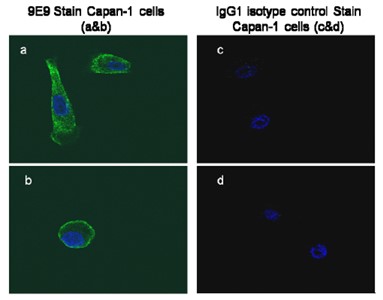Anti-Glypican-1 [Clone 9-E9]
Anti-Glypican-1 [Clone 9-E9]
Product No.: 34029
- -
- -
Clone 9-E9 Target Glypican-1 Formats AvailableView All Product Type Monoclonal Isotype Mouse IgG1 Applications IF , WB |
Data
- -
- -
Antibody DetailsProduct DetailsReactive Species Human ⋅ Mouse Host Species Mouse Immunogen Recombinant full-length human glypican-1. Product Concentration Lot Specific Formulation PBS, pH 7.4. State of Matter Liquid Product Preparation Purified by Protein G affinity chromatography Storage and Handling This antibody is stable for at least one (1) year at -20°C. Avoid multiple freeze- thaw cycles. Country of Origin USA Shipping Next Day 2-8°C Applications and Recommended Usage? Quality Tested by Leinco ELISA: at 1-5ug/ml will detect recombinant glypican-1 on the solid phase at 200ng/well.
Immunoblotting: at 1-10ug/ml, a band of approx. 64 kDa is detected in normal mouse brain. Immunofluorescence: at 1-10ug/ml, positive staining of human pancreatic carcinoma cell line Capan-1. These are recommended concentrations. User should determine optimal concentrations for their applications. Each investigator should determine their own optimal working dilution for specific applications. See directions on lot specific datasheets, as information may periodically change. DescriptionDescriptionSpecificity Mouse Monoclonal Antibody specific to native and
recombinant human and mouse
glypican-1. Background Glypican-1 is a widely expressed, GPI anchored, cell surface proteoglycan that has been reported to be important in cellular adhesion and migration. Glypican-1 also functions as an accessory molecule for signaling receptors. Glypican-1 is overexpressed in human gliomas and pancreatic ductal cell carcinomas. Expression of glypican-1 is associated with the aggressive behavior of tumor cells in vitro and in vivo. Function Cell surface proteoglycan that bears heparan sulfate. Binds, via the heparan sulfate side chains, alpha-4 (V) collagen and participates in Schwann cell myelination (By similarity). May act as a catalyst in increasing the rate of conversion of prion protein PRPN(C) to PRNP(Sc) via associating (via the heparan sulfate side chains) with both forms of PRPN, targeting them to lipid rafts and facilitating their interaction. Required for proper skeletal muscle differentiation by sequestering FGF2 in lipid rafts preventing its binding to receptors (FGFRs) and inhibiting the FGF-mediated signaling. {PubMed:19936054, PubMed:21642435}. NCBI Gene Bank ID UniProt.org Research Area Cancer Research References & CitationsTechnical ProtocolsCertificate of Analysis |




